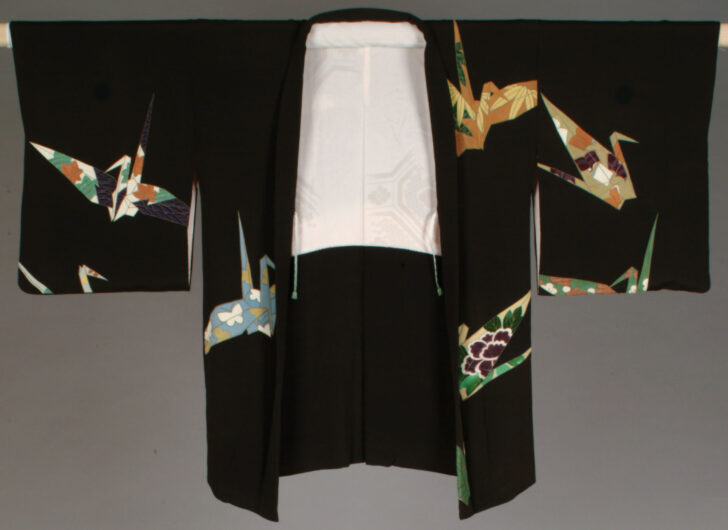Black crested haori with yûzen painted origami crane design
Japanese

Description
Throughout much of the twentieth century, the haori has been the standard outerwear for women who dress in kimono outside the home. Haori were originally part of a man’s formal attire in the Edo period (1615–1868), but in the nineteenth century, female entertainers in the capital, Edo (modern-day Tokyo), adopted it as a cloak for outdoor wear in mild weather. By the end of the twentieth century, married women of the upper class had begun to wear black silk crepe haori with family crests for formal, public occasions. Iwata Shizuko, the eldest daughter of the Iwata family and herself a business woman, usually wore—like her mother—haori made of black silk crepe with modest decorations and the Iwata family crest.
The haori frequently has a colorful lining in the upper half of the interior of the garment. The black haori with fan designs, for example, is lined with silk painted with a picture of fruits in pastel colors. Only when the haori was removed would these patterns have been glimpsed by others—an effect both playful and sensuous. This kind of discerning sensibility, known as the aesthetic of iki, developed in the late Edo period among cultural elites such as merchants and high-ranking geisha in response to the ruling Tokugawa government’s sumptuary laws, which regulated outward displays of luxury.
(Wrapped in Silk & Gold Exhibition, Summer 2010)
Subject Matter:
The haori was originally part of a man’s formal attire, but in the nineteenth century, female entertainers in Edo (modern Tokyo) adopted it as a cloak for outdoor wear in mild weather. By the end of the century, married women of the upper class adopted black crepe silk haori with family crests (such as that seen here, at the back of the collar) for formal, public occasions. For much of the twentieth century, the haori has been the standard outerwear for a woman who dresses in a kimono outside the home.
Physical Description:
Black crepe silk with origame crane designs hand-painted by paste-resist yûzen techinique, in colors and gold pigment. Lining is pink silk damask with woven pattern of truncated floral medallions. Double oak leaf crest (kashiwa) is embroidered with bokashi-dyed blue and white thread.
Usage Rights:
If you are interested in using an image for a publication, please visit https://umma.umich.edu/request-image/ for more information and to fill out the online Image Rights and Reproductions Request Form.